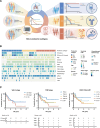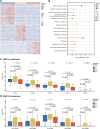Proteomic Stratification of Prognosis and Treatment Options for Small Cell Lung Cancer
- PMID: 38961535
- PMCID: PMC11423856
- DOI: 10.1093/gpbjnl/qzae033
Proteomic Stratification of Prognosis and Treatment Options for Small Cell Lung Cancer
Abstract
Small cell lung cancer (SCLC) is a highly malignant and heterogeneous cancer with limited therapeutic options and prognosis prediction models. Here, we analyzed formalin-fixed, paraffin-embedded (FFPE) samples of surgical resections by proteomic profiling, and stratified SCLC into three proteomic subtypes (S-I, S-II, and S-III) with distinct clinical outcomes and chemotherapy responses. The proteomic subtyping was an independent prognostic factor and performed better than current tumor-node-metastasis or Veterans Administration Lung Study Group staging methods. The subtyping results could be further validated using FFPE biopsy samples from an independent cohort, extending the analysis to both surgical and biopsy samples. The signatures of the S-II subtype in particular suggested potential benefits from immunotherapy. Differentially overexpressed proteins in S-III, the worst prognostic subtype, allowed us to nominate potential therapeutic targets, indicating that patient selection may bring new hope for previously failed clinical trials. Finally, analysis of an independent cohort of SCLC patients who had received immunotherapy validated the prediction that the S-II patients had better progression-free survival and overall survival after first-line immunotherapy. Collectively, our study provides the rationale for future clinical investigations to validate the current findings for more accurate prognosis prediction and precise treatments.
Keywords: Chemotherapy response; Immunotherapy; Prognosis; Proteomics; Small cell lung cancer.
© The Author(s) 2024. Published by Oxford University Press and Science Press on behalf of the Beijing Institute of Genomics, Chinese Academy of Sciences / China National Center for Bioinformation and Genetics Society of China.
Conflict of interest statement
Jun Qin and Yi Wang are cofounders and co-owners of the Beijing Pineal Diagnostics Co., Ltd., and Dongdong Zhan and Fang Cheng are employees of the Beijing Pineal Diagnostics Co., Ltd. All the other authors have declared no competing interests.
Figures





Similar articles
-
Exploring the role of TIGIT in patients with Small Cell Lung Cancer as a novel predictor of prognosis and immunotherapy response.Cancer Immunol Immunother. 2025 Mar 4;74(4):134. doi: 10.1007/s00262-025-03985-6. Cancer Immunol Immunother. 2025. PMID: 40035834 Free PMC article.
-
Differential Proteomic Analysis between Small Cell Lung Carcinoma (SCLC) and Pulmonary Carcinoid Tumors Reveals Molecular Signatures for Malignancy in Lung Cancer.Proteomics Clin Appl. 2018 Nov;12(6):e1800015. doi: 10.1002/prca.201800015. Epub 2018 Jul 5. Proteomics Clin Appl. 2018. PMID: 29888431
-
Construction of a prognostic model for extensive-stage small cell lung cancer patients undergoing immune therapy in northernmost China and prediction of treatment efficacy based on response status at different time points.J Cancer Res Clin Oncol. 2024 May 15;150(5):255. doi: 10.1007/s00432-024-05767-6. J Cancer Res Clin Oncol. 2024. PMID: 38750370 Free PMC article.
-
[Advances in Molecular Subtyping, Characteristics and Therapeutic Strategies of Small Cell Lung Cancer].Zhongguo Fei Ai Za Zhi. 2023 Apr 20;26(4):303-309. doi: 10.3779/j.issn.1009-3419.2023.106.08. Zhongguo Fei Ai Za Zhi. 2023. PMID: 37183645 Free PMC article. Review. Chinese.
-
Transitioning to a Personalized Approach in Molecularly Subtyped Small-Cell Lung Cancer (SCLC).Int J Mol Sci. 2024 Apr 10;25(8):4208. doi: 10.3390/ijms25084208. Int J Mol Sci. 2024. PMID: 38673793 Free PMC article. Review.
Cited by
-
Proteomic Analysis of FFPE Tissue Samples Identifies Potential Molecular Mechanisms Mediating Resistance to Radiotherapy in Rectal Cancer.J Proteome Res. 2025 Aug 1;24(8):3990-4001. doi: 10.1021/acs.jproteome.5c00114. Epub 2025 Jun 26. J Proteome Res. 2025. PMID: 40574313 Free PMC article.
-
Integrated multi-omics analysis and machine learning refine molecular subtypes and clinical outcome for hepatocellular carcinoma.Hereditas. 2025 Apr 12;162(1):61. doi: 10.1186/s41065-025-00431-6. Hereditas. 2025. PMID: 40221783 Free PMC article.
-
3D Printing for Cancer Diagnosis: What Unique Advantages Are Gained?ACS Mater Au. 2023 Aug 28;3(6):620-635. doi: 10.1021/acsmaterialsau.3c00046. eCollection 2023 Nov 8. ACS Mater Au. 2023. PMID: 38089653 Free PMC article. Review.
-
A Multi-Omics Framework for Survival Mediation Analysis of High-Dimensional Proteogenomic Data.ArXiv [Preprint]. 2025 Mar 11:arXiv:2503.08606v1. ArXiv. 2025. PMID: 40160448 Free PMC article. Preprint.
References
-
- Gazdar AF, Bunn PA, Minna JD. Small-cell lung cancer: what we know, what we need to know and the path forward. Nat Rev Cancer 2017;17:725–37. - PubMed
Publication types
MeSH terms
Substances
LinkOut - more resources
Full Text Sources
Medical

